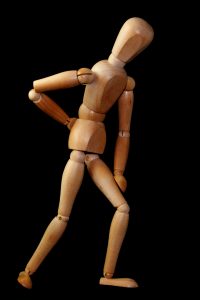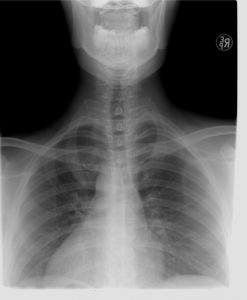Whether our pain is the result of an accident, a choice that we or someone else made, or a rock falling from the sky, it can be something that we wish to quickly remove from our lives. Our exact physical make-up is different from person to person. However, nearly everyone has pain receptors that will register pain in some form as the body and brain communicate.
Those pain receptors may need a bit of redirection as injuries and ailments begin to heal. Otherwise, pain may become at home within our bodies and become more difficult to overcome. “Carey and Freburger noted that more than 80 percent of Americans will experience an episode of low back pain at some time in their lives…,” reads the UNC School of Medicine. The goal often includes minimizing the risk of for chronic pain by eliminating acute pain efficiently and effectively.
Chronic Back Pain Defined

Acute versus chronic pain? What is the difference anyway? Acute pain results from an initial injury or disease and may last only a few moments. It is possible for acute pain to last a few days or even months depending on the injury or source. It is an alert to the body that there is a problem. Once the injury or disease is resolved, acute pain goes away.
Chronic pain is persistent pain, often lasting for months – and sometimes years. Pain may begin acutely and later become chronic. In short, chronic pain persists after damaged tissue in the body has healed.
Chronic pain may have no apparent cause – but is still very real for the sufferer. This type of pain may also be more disruptive to life, causing sleep disruptions, work difficulties, and reduced productivity. Chronic pain is often harder to overcome than acute pain, in part, because locating the cause of the pain is sometimes more difficult.
With chronic pain, the body may have become so accustomed to accommodating an underlying issue that its muscles, ligaments, and tendons may have ‘forgotten’ how they initially functioned. The body and brain must often be retrained to work together and recognize that healing has taken place and an alert for danger is no longer necessary.
It can take time for chronic pain to develop in the body. Just the same, it takes time for recovery to take place. Not every chronic issue will be completely solvable. However, remarkable progress can often be made. Pain management may become something to consider for the well-being of some patients.
What Parts of the Body Make Up the Back?
 When discussing care and pain issues, the back is generally broken up into sections for simplicity. Note that the included areas connect much of the body together. Joints and limbs are often affected by back pain issues because they are closely related to the motions and actions completed by parts of the back. In turn, chronic back pain is often easily intensified by actions that are completed by other parts of the body.
When discussing care and pain issues, the back is generally broken up into sections for simplicity. Note that the included areas connect much of the body together. Joints and limbs are often affected by back pain issues because they are closely related to the motions and actions completed by parts of the back. In turn, chronic back pain is often easily intensified by actions that are completed by other parts of the body.
These four areas make up the back:
- Cervical (neck area supporting the head)
- Thoracic (upper back protecting internal organs)
- Lumbar (lower back area helping to carry the torso)
- Sacral Spine (sacrum bone, connecting to the pelvis)
What Causes Chronic Back Pain?
“Back pain from resultant lower back muscle spasms can be severe, and back pain from a number of these types of conditions can become chronic,” states Better Health Chiropractic in Alaska.
Here are some common factors that may contribute to chronic back pain:
- herniated or bulging discs
- misaligned or degenerating discs
- arthritis
- pinched nerves
- strained muscles
- subluxations
- unknown or hidden injuries
Individuals experiencing the following situations may be at a higher risk for chronic back pain:
- Injuries that do not heal well
- Poor posture over time
- Lifting heavy objects with improper form – especially if repeated
- Excess body weight
- Spinal curvatures
- Poor mattress, poor sleep positions
- Degenerative changes in the spine due to aging
- Disease (such as fibromyalgia, multiple sclerosis, arthritis)
- High heels – especially if worn regularly
- Lack of medical care to aid in proper healing of acute pain
These factors are often found in combination with one another. Therefore, as one or more factors become minimized, others may often become minimized as well. Pain may also have a source that is not readily known. This can make healing more difficult but not unattainable.
How bad is your pain?
Take our QUIZZES below and find out!
Chronic Back Pain: Brief Demographics

Men, women, young, old, and all skin tones are at risk for all types of back pain. The risk is part of having a human musculoskeletal system. Immunity does not come easily. The percentage of the population suffering from chronic back pain has been on the rise in recent decades.
“The prevalence of chronic LBP (low back pain) more than doubled in the 14-year interval from 3.9 (1992) to 10.2 (2006) percent. This marked increase occurred among all gender, age, and race/ethnic subgroups,” reads a report noted by the National Center for Biotechnology Information by this team of physicians.
Women and those of the older generations are slightly more likely to develop chronic back pain. For the female category, this appears to be, in part, due to the physical requirements that come with having another human held within one’s body. Of course, such a bundle does not often get any smaller once it is outside the woman’s body.
“When asked about four common types of pain, respondents of a National Institute of Health Statistics survey indicated that low back pain was the most common (27%), followed by severe headache or migraine pain (15%), neck pain (15%) and facial ache or pain (4%),” notes the American Academy of Pain Medicine with information from the National Centers for Health Statistics. This is a significant number of individuals – many of whom will require medical treatment to allow or expedite healing in some way.
A significant number of patients who experience back pain will heal and be able to move forward without chronic pain problems. Those who treat initial injuries and ailments early are more likely to recover in a timely manner and avoid chronic pain issues. However, even with proper care and management, some back pain problems will need regular care to continue to minimize chronic pain matters.
Age Variances
While we see that age does play a role in the presence of chronic back pain, the same risk factors still apply regardless of age. One key difference for the older community is that healing does not come as easily as we age. Injuries, disease, improper lifting, etc. all become greater risk factors to consider once we reach the senior years.
Acquired ailments tend to stay around longer – increasing the likeliness for pain to become chronic. Everyday risks easily become hazard traps for bodies that may not heal as quickly. Greater care must be taken to expedite healing for long-term health as we mature.
Developing Regions of the World and Back Pain
Numbers vary from continent to continent regarding the quantity of patients with reported chronic back pain. “According to the World Health Organization, musculoskeletal conditions are the leading cause of long-term disability worldwide.” One obvious factor in this relates to the availability of health care. Developing regions tend to have a higher rate of unreported chronic pain complaints, often relating to poor work conditions.
“Spinal disorders represent the vast majority of these conditions in the developing world. Patients suffer with enormous pain, often with only a naproxen to help ease their suffering. Due to the immense pain and dysfunction, many patients become entirely disabled,” reads Spine-Health. Access to proper care and education in the initial stages of injury increase a patient’s chances for avoiding chronic back pain. Hence, individuals in developing regions often remain in chronic pain for the duration of their lives, unaware that continued physical pain may have been unnecessary.
Pain Relievers and Chronic Back Pain
The Western public has seen a new emphasis on opioid and benzodiazepine pain relievers. Hard core medications may have their place in the world of health care. However, brain-altering chemicals such as these have become extremely prevalent in the last two to three decades. “And while opioids are invaluable for acute pain, they’re less effective for persistent, chronic pain. In fact—in a particularly cruel irony—long-term opioid treatment can actually make pain worse,” explains Eleanor Nelsen in Nova Next.
With the quantity of chronic pain sufferers increasing, creative options must be sought for the benefit of patients who may wish not to use such aggressive medications. According to the National Center for Complementary and Integrative Health, “Long-term use of opioid drugs usually does not improve functioning for patients with chronic low-back pain. However, these patients may benefit from nondrug therapies, including spinal manipulation.”
Non-Chemical Pain Management
Here are a few considerations that can help to minimize the risks for becoming a chronic back pain sufferer.
- Keep a spine-friendly posture while sitting and standing.
- Use your legs if heavy lifting becomes a must.
- Stay active. Keep back muscles strong and flexible.
- Consume healthy foods that promote nutrition throughout the body.
- Seek regular medical attention for proper healing of injuries and ailments.
- Do what you can to prevent injuries.
- Choose ergonomic workplace options.
- Consider chiropractic care treatments for acute and chronic back pain.
Even for individuals who are unsure if their pain is acute, chronic or a bit in between, options are available. “Most of our patients are dealing with lumbar pain, degeneration symptoms, arthritic conditions, bulging & herniated discs, spinal injuries from work and outdoorsy stuff…” as shared on our Conditions page.
Seeking Medical Care
Chronic back pain may be a sign that medical care was needed long ago. The sooner ailments are assessed, the sooner healing can begin. Patients may become so accustomed to their pain, that small changes may begin to go unnoticed. A patient may have begun to forget what it felt like not to have regular pain. Suffering from chronic back pain does not have to be a ‘new normal.’
Are Chiropractic Patients Satisfied with Their Care?
How do patients feel about the care they receive from chiropractors? “About eight in 10 (chiropractic users) agree the quality of care is a good value for the money,” reads this 2016 Gallup-Palmer College of Chiropractic Report. Exact ratios varied depending on the length of time since care had been received. This particular study also discusses the relationship between chiropractors and patients.
Chiropractors choosing to help educate patients showed a direct correlation to the number of patients who felt their provider actually cared about them. Patients who are given the opportunity to understand their options are more likely to be satisfied with their care. Chronic back pain sufferers can best be served when they have the tools needed to make decisions regarding their care.
The American Chiropractic Association notes, “With today’s growing emphasis on quality care, clinical outcomes and cost-effectiveness, spinal manipulation is receiving increased attention.” Advanced technologies in chiropractic care also help to expedite healing with safe practices that insurance companies support. A push in recent years for natural healing has urged back pain sufferers to seek drug and surgery-free options.
How Many Receive Care at Better Health in Alaska?
10,000+ Alaskans (have) benefited from the care of the chiropractic and physical rehab team in Anchorage, Juneau & Wasilla at Better Health Chiropractic & Physical Rehab. Clients are encouraged to learn about and understand all of the care benefits that may be offered for their specific ailments.
Contact Better Health today to learn what care may be best for your specific needs. Call (877) 346 5255. Physicians stand at the ready to help clients leave their pain behind. Insurance and payment plans are available.
Schedule an Appointment, Receive a One-Hour Massage Certificate!
That’s right! Receive a certificate for a free one-hour massage with one of our highly-trained, professional, and licensed massage therapists for use after your first appointment. You can use it yourself, or give it to one of your family or friends for them to use!
[gravityform id=7 title=false description=false]














